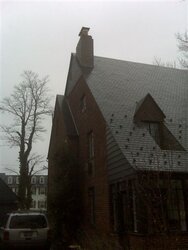That's what I was thinking would be best: Rigid at the top 35 feet, and flex at the bottom ~10 feet. You agree?
That is what I did, cept I only used 5' of flex at bottom, you may need the 10, whatever works for your set up. It would stand to reason, a smoother surface will collect creo less easily and clean more easily. I would think flex would be much more likely to collect creosote than rigid.
My draft is freaking rediculous. I could probably start a fire 3 feet into my living room and the chimney would suck it right up. I pull a log out of the fire twirl it around and never need to worry about smoke in the living room. Even when I had the insert in there (only a little over a day) I would often forget to open the damper on the insert, relying on the ~1"x10" heat chamber exhaust, and I'd often still not get smoke in the room.
With inserts is not likely able to do on most, but if you can, you may want to think about a damper right out of the insert outlet. You may be fine without, but 45 foot is going to suck some exhaust, especially on colder days/nights. I have 27' and she draft damn good.
I just measured the inside, and once again, my chimney sweep if full of $h!t. He said I had nearly 50' of chimney, and I've got less just than 37 feet from the fireplace floor to the bottom of the peak ridgeline plank. I think I've got another 3-4 feet of chimney above that, so it's still probably more than 40'. Still a crazy draft.
Yeap, you should have no draft problems, well mayber over draft but not too little draft.
Do you know how chimney distance affacts the needed cross section? Would a longer chimney need a larger or smaller liner? (Just curious, I'm not going any smaller than 8".)
No, your fine with the 8" your going to have more draft than you know what to do with.
Thanks for the tips like "vermiculite" and rock wool.
My Next steps:
- Get a contractor who will install the liner (I think my slate roofer wants the work, and will probably be very reasonable.)
- Have him decide whether he wants to go flex, rigid, and if he wants to insulate. (I'm not htinking that I "need" it.)
If you can get the double wall rigid down there, I suggest it. Then use the flex you need to get to the bottom. Then you will not need additional insulation.
- Figure out which stove I'm going to be using going forward (trying to get my hands on an old Vermont Castings 0044 because it's probably better than my "Vermont Stove Company" Shelburne. Both look nice.
- Order up the materials.
I have to admit one other thing is at least interesting to me: The concept of heating water in the winter. I've got radiator heat, and I also need to replace my water heater. I'm looking at going with a tankless, and envisioning I could cut winter water heating costs by running some pipes through my firebox.

I read a cool thread on that, but figure it's probably not worth it when I spend less than $60 per month on hot water. It would take an eternity to get a return on that investment. Maybe it makes more sense to look at some type of oil burner that combines hot water and radiator heat.
Running water through your firebox, especially if not designed to do so, will only keep firebox temps down lower than normal. May or may not become a PITA.
This site forum has been EXTREEMLY HELPFUL and interesting. THANK YOU

!
Thats what the site is here for. We get helped, then pass help along to others.



 I read a cool thread on that, but figure it's probably not worth it when I spend less than $60 per month on hot water. It would take an eternity to get a return on that investment. Maybe it makes more sense to look at some type of oil burner that combines hot water and radiator heat.
I read a cool thread on that, but figure it's probably not worth it when I spend less than $60 per month on hot water. It would take an eternity to get a return on that investment. Maybe it makes more sense to look at some type of oil burner that combines hot water and radiator heat.  !
!